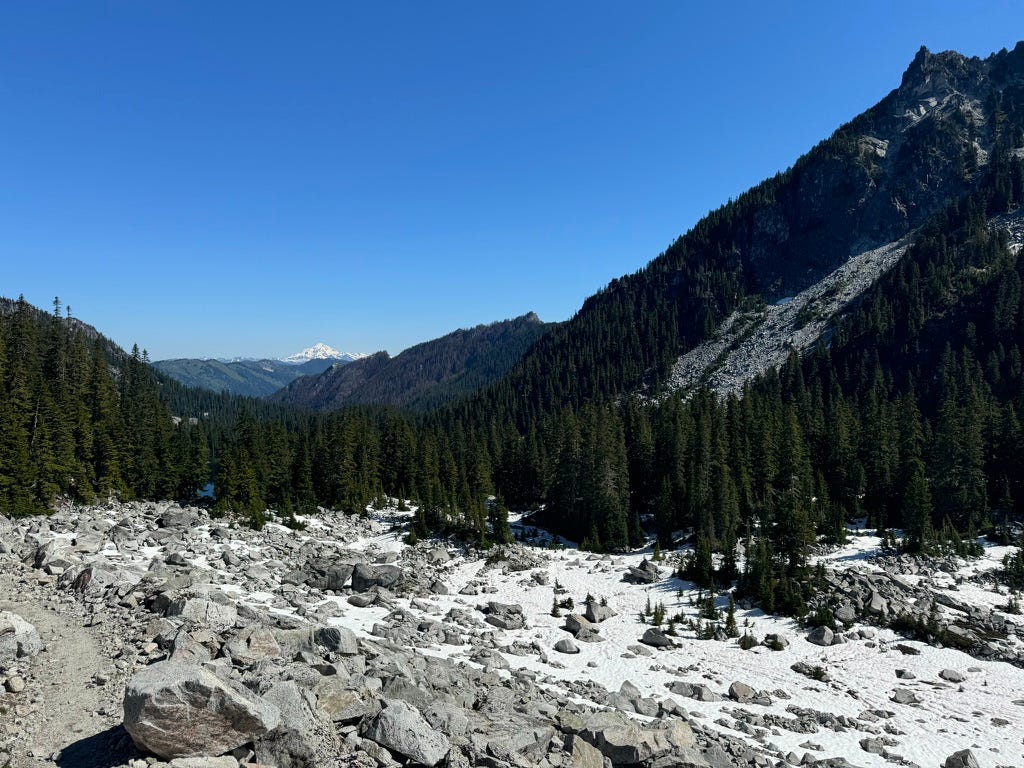Decisions
the importance of decision making
I sat on a log in a flat part of the trail near a junction. I was 35 miles into a planned 70+ mile hike. I had a decision to make, and enough data to make the decision. The challenge, as always with decision making is how much to rely on data, and how much to rely on your gut.
Leaders Make Decisions
Early in my career, I began to notice a pattern with a few of the leaders I admired. They were all really good at making a confident decision - no matter how much - or how little data they had. If a decision needed to be made, they made it and moved forward. They moved forward, and then - if the data showed that a change in direction was needed after all, they’d adapt.
In Blink, Malcom Gladwell talks about Thin-Slicing and the Adaptive Unconscious. Thin-slicing refers to our ability to use limited information from a very narrow period of experience to come to a conclusion - which allows us to make decisions quickly and often accurately without needing to process a large amount of data. The Adaptive Unconscious (similar to thinking “Fast” in Kahneman’s Thinking Fast and Slow) is a part of our brain that processes information quickly and efficiently without our conscious awareness, and enables us to make split-second decisions based on patterns and cues that we might not even be consciously aware of.
What I learned over time was that these seemingly intuitive-based decisions were indeed subconsciously based on data and facts.
Data Slaughters Intuition
One challenge is that a lot of people get so good at making good decisions subconsciously that they rely too much on their gut and not enough on data. Classic A/B Testing experiments (example) show how gut feel fails when compared with real data. You’ll never have all of the data you need to make a decision, but you are obligated to find all of the information available to make a decision.
Always look for more data, but move on when you have enough.
Mistakes and Fear
Much too often, people are afraid to make a decision because they’re afraid they will be wrong. This fear, unfortunately comes from organizations (or past experiences) that not only penalize people for mistakes, but flat out refuse to give people permission to fail. The challenge is in something else I’ve noticed over the years.
The people who are good at making decisions are good because they’ve made hundreds or thousands of decisions.
They way you get good at anything is from deliberate practice. If you want to get good at decisions, you need to make a lot of decisions - then take time to learn.
It Gets Worse
One of your major roles as a leader is to grow more leaders. If one of the qualities of leadership is to make decisions, then you need to let your team make decisions. You need to make them make decisions. Let them make a lot of decisions, and let them make wrong decisions (and learn from them).
Once, I was managing a team that was responsible for, among other things, release engineering - which meant I made choices about what changes would go into a release (a little like Chuck Rossi did at Facebook for some time). We had a beta release coming up, and a team came to me with a bug fix. It fixed a major problem with downloads in several regions - and that’s it. It had no effect on the application nor other regions. There were zero problems in testing. It was isolated and safe. Given the data - along with my experience - I approved the change and had it set for release the next week.
Data + Intuition = Decision.
The problem I didn’t expect was that my manager had decided that releases were now important enough that he needed to sign off as well. It was a power trip, but I let him roll with it. He called me at home on a Friday night and told me (ok - he was yelling) that I was “playing with fire” and to back out the change. I remained confident in my original decision, but now I had two choices. Do what was right for the customer, or back out the change and keep my job.
Sign-Off Culture
The example above is extreme, but sign-off culture exists, and it sucks. Decision making is a critical part of leadership, but too many organizations give leaders the illusion of decision making, but then insist that someone higher up the chain approves that change. Not only does it crush morale of the pseudo-decision makers, but it adds inefficiencies and bottlenecks all the way up the system.
I worked with a development manager once who insisted that the role of the test team (this was in the days of huge test teams) was “to sign off”. Me being me, I told him that was a stupid idea. The test team didn’t have the power to delay a release by refusing to sign off, so the idea was dead in the water from the start. This was 2013, and while whole-team quality wasn’t commonly discussed, it was a thing and it was an important thing. He was a stubborn dude, but I made some headway anyway.
I hate sign-off culture - it’s a waste of time and energy.
Decisions Lead to Decisions
Often, the choice you make dictates the future choices you need to make. I left Steven’s Pass on a Wednesday afternoon knowing I had a challenging hike ahead of me. Temperatures were going to be in the nineties - but despite the heat, there was still substantial snow on the trail.
My first decision was to start. I’m confident on snow (I learned to self-arrest when I was eight), and brought an ice axe and spikes. Sure enough, I ran into snow within a few miles. I didn’t need any safety equipment, but a map and gps were certainly helpful in finding the trail.
Stop - Think - Go
Early Wednesday evening, I had a more difficult decision to make. My water filter wasn’t working. I practically over-maintain it, and had used it a month ago, so I was at a loss. Briefly, I wondered if I should turn around, but I took a moment to think about the data I had, and made a decision. I had water, I had fuel to boil water, and there was a non-zero chance I could fix the filter on-trail. I went on. A mile or so later, I found another hiker who filtered a few liters for me. I was fine.
Often, we make the decision that allows us to move forward, knowing that while we are continuing forward progress, that we are also deferring another decision until later when we have more data. It’s critical to always collect more data and learn. When I made the choice to take a bug fix into an upcoming release, I knew that I’d have days of telemetry and data to look at before the release, and was ready to adapt if needed. In fact, I looked at the data after backing out the change, and all signs still told me what the right thing to do was.
Make a decision and move forward - but pay attention to as well.
Outcomes…
While decisions often lead to more decisions, eventually, they all lead to outcomes. When I make a choice on a restaurant for dinner, the outcome is I get a meal that I may or may not like - but the outcome is based on my decision.
In the case of the bug fix that wasn’t, the next release went really well - except, of course, for users in specific regions. They complained, so we shipped the fix that we already knew would work and everyone was (relatively) happy.
…and Hard Choices
As I sat on that log, I took time to evaluate the data I had. I was not able to fix my water filter. I found that if I sucked on it like a straw, that I could get some water out, but not enough. I had been rationing water, and was feeling constantly parched and dehydrated. I had boiled a few liters of water at this point - which had slowed me down significantly, but also used a lot of the minimal fuel I usually bring on a trip). It was approaching the mid 90s (F), and would stay that way for the remainder of my trip. Finally, despite it being a holiday weekend, the snow conditions on the trail had chased away most of the other hikers, so the odds of me finding someone to filter water for me near a stream crossing were pretty low.
I was 12 miles into the day already, but given the data, I sent a satellite message to my family for extraction, and then hiked 12 more miles to a trailhead where they could pick me up. I didn’t like the decision, but it was the right decision. I was disappointed, but safe.
Choose and Reflect
I don’t regret my decision to stop my hike. It was the right decision, and it was based on all of the data I had. The point is that we learn from all of our decisions. Take time to reflect on the choices we make - learn from the mistakes, and build on the good choices - and practice making a lot of decisions.
-A 7:0






I learned a lesson while interviewing recently, when asked about "a time when..." I had to make an important decision, I had a hard time explaining my reasoning, although it was the right decision in this case, I found it a good exercise to go back in my career and evaluate some decisions and challenge myself to think about what experiences or data did I have to make it.
Great post, thanks for sharing
This is a great article, and like Vernon I think the “Mistakes and Fear” section cuts to the heart of the problem. People who are afraid of decisions tend to overweight process vs judgment. There is nothing wrong with processes, they are essential for any large organization, but all too often organizations will fall into the trap of thinking that if some process is good, more must be better. At that point, process takes over, judgment is devalued, and the result is mediocrity. This is the Petri dish in which sign-off culture thrives.